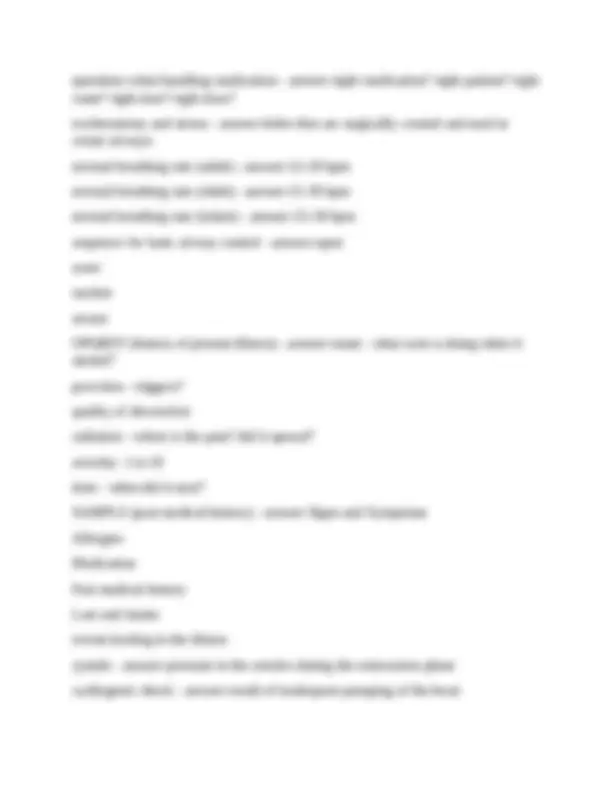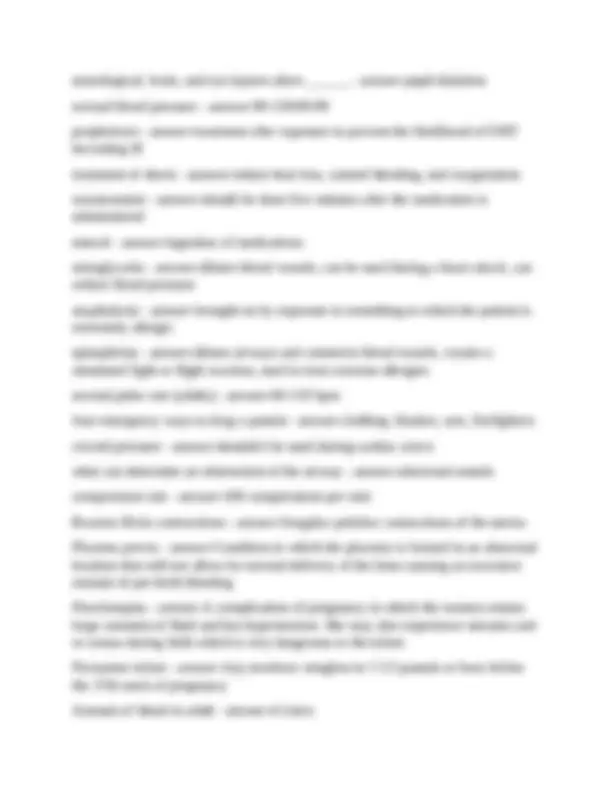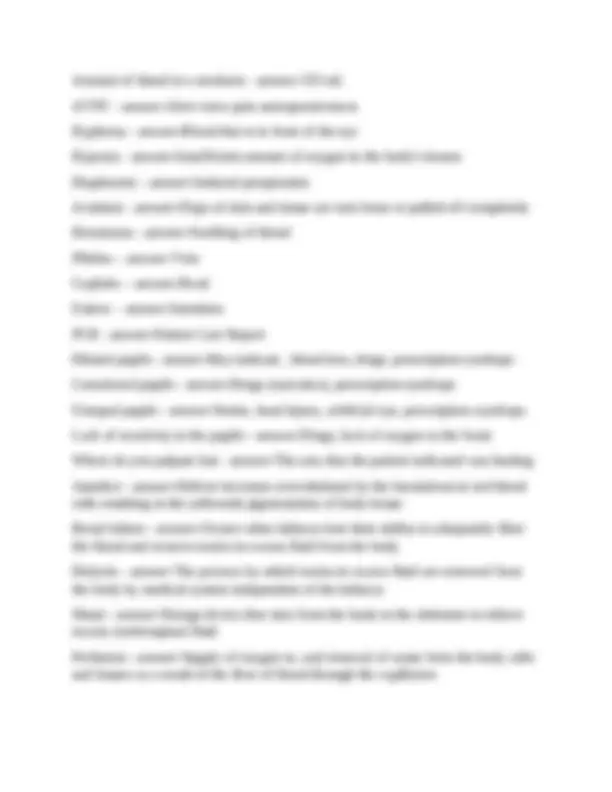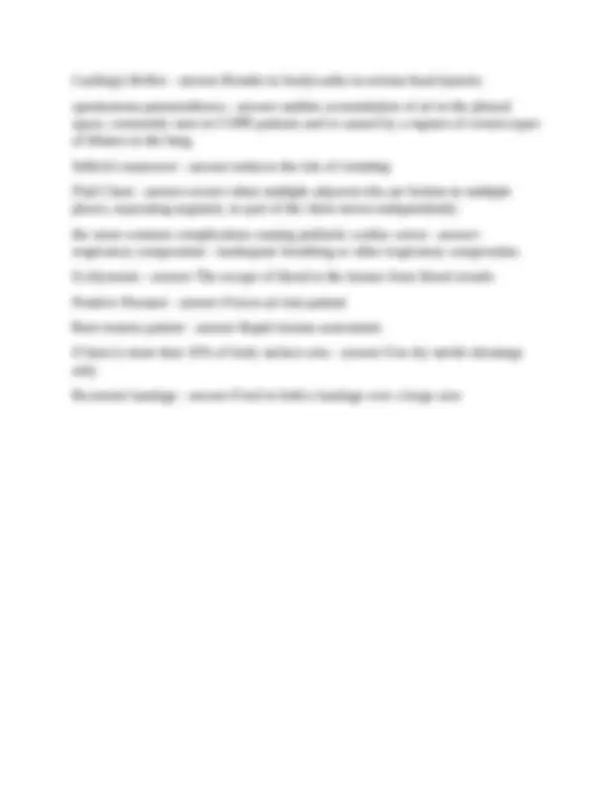






Study with the several resources on Docsity

Earn points by helping other students or get them with a premium plan


Prepare for your exams
Study with the several resources on Docsity

Earn points to download
Earn points by helping other students or get them with a premium plan
Community
Ask the community for help and clear up your study doubts
Discover the best universities in your country according to Docsity users
Free resources
Download our free guides on studying techniques, anxiety management strategies, and thesis advice from Docsity tutors
A wide range of topics related to emergency medical technician (emt) training and knowledge. It includes information on contraindications, medication administration, personal protective equipment (ppe), basic emt skills, patient transport methods, airway management, vital signs, shock, medication administration, respiratory distress, seizures, trauma assessment, and more. A comprehensive study guide or reference material for emt students or professionals. It provides detailed answers to numerous questions and scenarios that emts may encounter in their work, making it a potentially valuable resource for emt education and training.
Typology: Exams
1 / 8

This page cannot be seen from the preview
Don't miss anything!





contraindication - answer-reasons not to use a medication aspirin - answer-prevents platelets in the blood from clotting boots and back braces - answer-accessories that EMTs use when lifting a pateint actions in controlling airway - answer-opening and securing hypoperfusion - answer-inadequate supply of oxygen, glucose, and other nutrients examples of PPE (personal protective equipment) - answer-pocket mask (covers mouth and part of your nose) mask (whole face) gloves gown basic skills for emt - answer-infection control airway control ventilation bleeding control parenteral - answer-inhalation and injection of medience 6 emergency way to carry a patient - answer-1. rescuer assist
oropharyngeal - answer-disposable molded plastic device designed to help keep the tongue off the roof of the mouth diastolic - answer-pressure in the arteries immediately after the pulse on-line medical control - answer-physician is there with the EMT neurogenic shock - answer-vessels are dilated losing pressure and ability to pump blood against gravity extrinsic diseases - answer-diseases that are contagious and able to spread bronchodilators - answer-increases airflow by increasing bronchioles diameter (i.e. inhaler) direct lift - answer-from floor to bed discs - answer-shock absorbers in the back that can cause pain what do you administer if there is respiratory difficulty or patient suspected to be in shock, had stroke or seizure - answer-oxygen Vector - answer-a living creature involved in the transmission of the disease (humans, dogs, cats, chicken) crowing - answer-a sound that can occur when muscles around the larynx spasm Auscultation - answer-the act of listening vital signs - answer-should be repeated every 10-15 minutes snoring - answer-tongue blocks the airway septic shock - answer-caused by an infection that results in dilated blood vessels EMTs should be able to lift at least ____lbs - answer- signs of shock - answer-tachycardia (rapid heart rate) tachypnea (rapid breathing) nausea thirst confusion cool and pale skin
neurological, brain, and eye injures alters ______ - answer-pupil dialation normal blood pressure - answer-90-150/60- prophylaxis - answer-treatment after exposure to prevent the likelihood of EMT becoming ill treatment of shock - answer-reduce heat loss, control bleeding, and oxygenation reassessment - answer-should be done five minutes after the medication is administered enteral - answer-ingestion of medications nitroglycerin - answer-dilates blood vessels, can be used during a heart attack, can reduce blood pressure anaphylaxis - answer-brought on by exposure to something to which the patient is extremely allergic epinephrine - answer-dilates airways and constricts blood vessels, creates a simulated fight or flight reaction, used to treat extreme allergies normal pulse rate (adults) - answer-60-110 bpm four emergency ways to drag a pateint - answer-clothing, blanket, arm, firefighters cricoid pressure - answer-shouldn't be used during cardiac arrect what can determine an obstruction of the airway - answer-abnormal sounds compression rate - answer-100 compressions per min Braxton Hicks contractions - answer-Irregular prelabor contractions of the uterus Placenta previa - answer-Condition in which the placenta is formed in an abnormal location that will not allow for normal delivery of the fetus causing an excessive amount of pre-birth bleeding Preeclampsia - answer-A complication of pregnancy in which the women retains large amounts of fluid and has hypertension. She may also experience seizures and or comas during birth which is very dangerous to the infant Premature infant - answer-Any newborn wingless in 5 1/2 pounds or born before the 37th week of pregnancy Amount of blood in adult - answer-4 Liters
Amount of blood in a newborn - answer-335 mL AVPU - answer-Alert voice pain unresponsiveness Hyphema - answer-Blood that is in front of the eye Hypoxia - answer-Insufficient amount of oxygen in the body's tissues Diaphoretic - answer-Induced perspiration Avulsion - answer-Flaps of skin and tissue are torn loose or pulled off completely Hematoma - answer-Swelling of blood Phlebo- - answer-Vein Cephalo- - answer-Head Entero- - answer-Intestines PCR - answer-Patient Care Report Dilated pupils - answer-May indicate , blood loss, drugs, prescription eyedrops Constricted pupils - answer-Drugs (narcotics), prescription eyedrops Unequal pupils - answer-Stroke, head injury, artificial eye, prescription eyedrops Lack of reactivity in the pupils - answer-Drugs, lack of oxygen to the brain Where do you palpate last - answer-The area that the patient indicated was hurting Jaundice - answer-Deliver becomes overwhelmed by the breakdown in red blood cells resulting in the yellowish pigmentation of body tissue Renal failure - answer-Occurs when kidneys lose their ability to adequately filter the blood and remove toxins in excess fluid from the body Dialysis - answer-The process by which toxins in excess fluid are removed from the body by medical system independent of the kidneys Shunt - answer-Drange device that runs from the brain to the abdomen to relieve excess cerebrospinal fluid Perfusion - answer-Supply of oxygen to, and removal of waste from the body cells and tissues as a result of the flow of blood through the capillaries
Noncardiac chest pain - answer-Pneumonia, rib fracture, pneumothorax, pleurisy, esophageal spasm, gastric ulcer disease. Assessment for patient in respiratory distress (unresponsive) - answer-Primary assesment, rapid physical examination, baseline vital signs, and history Congestive heart failure causes - answer-Fluid swelling Hypoglycemia (low blood sugar) - answer-Sudden, cool moist skin, pupils dilated, elevated blood pressure Hyperglycemia (high blood sugar) - answer-Warm dry skin, normal pupils, deep breaths, gradual Tonic-clonic phase - answer-Muscular contraction phase of seizures, usually most violent, patient may scream, foam, and stop breathing Management of seizures - answer-Move all objects that are near victimbdo not touch or restrain him or her Papoose - answer-Total body restraint Visceral pain - answer-General pain in the abdomen the result of an illness involving an organ Pyelonephritis - answer-Severe infection of the kidney Oxygen - answer-Should be given to any patient lethargic or short of breath Activated Charcoal - answer-Can be administered after a patient ingests a poison that is not caustic(able to burn) Velocity - answer-Important in determining severity of trauma Spinal Immobilization - answer-Should be immediately applied in trauma accident DCAP-BTLS - answer-Deformity Contusion(bruise) Abrasion(scrape) Puncture- Burn Tenderness Laceration Swelling Jugular Venous Distention - answer-Can indicate serious chest injury Guarding - answer-The tightening of abdominal muscles. Body parts (teeth, pieces of ear) - answer-Wrap in moist gauze so they can be reconnected Treatment for the eye - answer-Cover both eyes, no pressure, lay patient down
Cushing's Reflex - answer-Results in bradycardia in serious head injuries spontaneous pneumothorax - answer-sudden accumulation of air in the pleural space, commonly seen in COPD patients and is caused by a rupture of certain types of blisters in the lung. Sellick's maneuver - answer-reduces the risk of vomiting Flail Chest - answer-occurs when multiple adjacent ribs are broken in multiple places, separating segment, so part of the chest moves independently. the most common complication causing pediatric cardiac arrest - answer- respiratory compromise - inadequate breathing or other respiratory compromise. Ecchymosis - answer-The escape of blood to the tissues from blood vessels Positive Pressure - answer-Forces air into patient Burn trauma patient - answer-Rapid trauma assessment If burn is more than 10% of body surface area - answer-Use dry sterile dressings only Recurrent bandage - answer-Used to hold a bandage over a large area